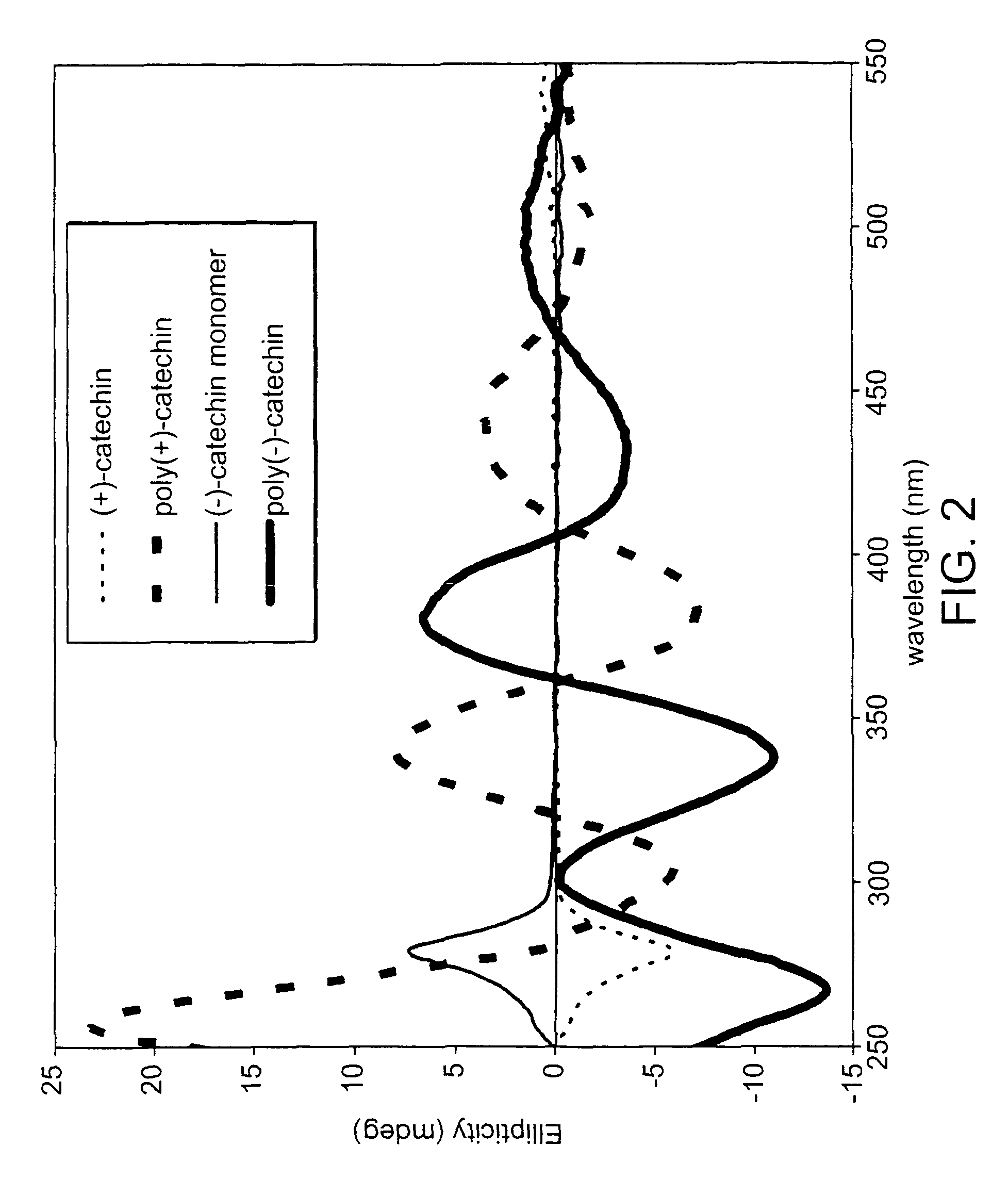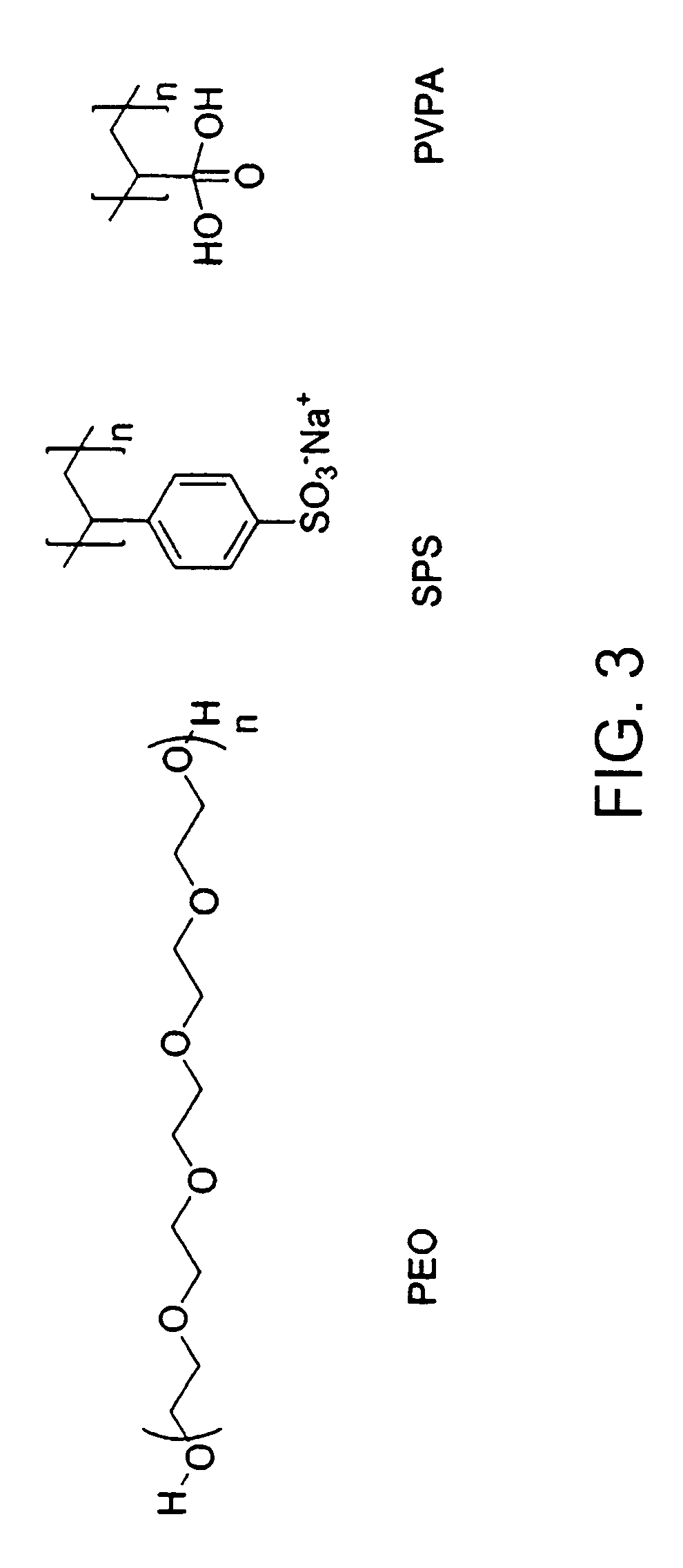Synthesis of oligo/poly(catechins) and methods of use
a technology of oligo/polyflavanoids and oligo/polyflavanoids, which is applied in the direction of biocide, plant/algae/fungi/lichens ingredients, biocide, etc., can solve the problems of high instability, disadvantages of natural flavanoids such as egcg, and the inability to prolong the survival of murine cardiac allografts, so as to improve the activity of oligo/polyflavanoids
- Summary
- Abstract
- Description
- Claims
- Application Information
AI Technical Summary
Benefits of technology
Problems solved by technology
Method used
Image
Examples
examples 1-7
Synthesis and Properties
[0189]A typical reaction for synthesizing a biocompatible, water-soluble oligo / polyflavanoid occurs in a solvent (e.g., aqueous media), typically buffered (e.g., at about pH 7) with typically only the flavanoid monomer (e.g., catechin), the biocompatible polymerization solubilizer (e.g., polyethylene oxide (PEO) and / or water-ethanol) and the polymerization agent (e.g., a catalytic amount of a peroxidase enzyme such as horseradish peroxidase (HRP) and hydrogen peroxide:
[0190]
[0191]These reactions can typically be carried out as one-step, one pot reactions. The non-toxic nature of the process and aqueous solubility of the oligo / polycatechins facilitates ease of deliverability of these materials into biological systems. The use of a biocompatible polymerization solubilizer as a template also can allow one to tailor the nature of coupling of the monomers to obtain the desired products. Examples of polyelectrolyte templates as polymerization solubilizers in enzyma...
example 1
Biocompatible, Water-Soluble Oligo / Poly(+)-Catechin Synthesized in Presence of PEO
[0195]A biocompatible polymerization solubilizer (13.41 μl of PEO) was dissolved in deionized water (10 mL) containing (+)-catechin (3.44 mM) at pH 7.0. This was followed by the addition of 4 mg of HRP as polymerization agent to this solution. The polymerization was initiated by the addition of 1021 μl of 0.3% hydrogen peroxide.
example 2
Biocompatible, Water-Soluble Oligo / Poly(−)-Epicatechin Synthesized in Presence of PEO
[0196]Polymerization of (−)-epicatechin in the presence of PEO catalyzed by HRP using hydrogen peroxide under ambient conditions. 13.41 μl of PEO was dissolved in deionized water (10 mL) at pH 7.0 for the polymerization of catechins. This was followed by the addition of 4 mg of HRP to this solution. The polymerization was initiated by the addition of 1021 μl of 0.3% hydrogen peroxide.
[0197]FIG. 4 is an ultra violet-visible (UV-Vis) absorption spectrum of Oligo / poly [(−) and (+)-catechin)] / PEO complex synthesized at pH 7 using HRP as a catalyst
PUM
| Property | Measurement | Unit |
|---|---|---|
| molecular weight | aaaaa | aaaaa |
| molecular weight | aaaaa | aaaaa |
| molecular weight | aaaaa | aaaaa |
Abstract
Description
Claims
Application Information
 Login to View More
Login to View More - R&D
- Intellectual Property
- Life Sciences
- Materials
- Tech Scout
- Unparalleled Data Quality
- Higher Quality Content
- 60% Fewer Hallucinations
Browse by: Latest US Patents, China's latest patents, Technical Efficacy Thesaurus, Application Domain, Technology Topic, Popular Technical Reports.
© 2025 PatSnap. All rights reserved.Legal|Privacy policy|Modern Slavery Act Transparency Statement|Sitemap|About US| Contact US: help@patsnap.com



